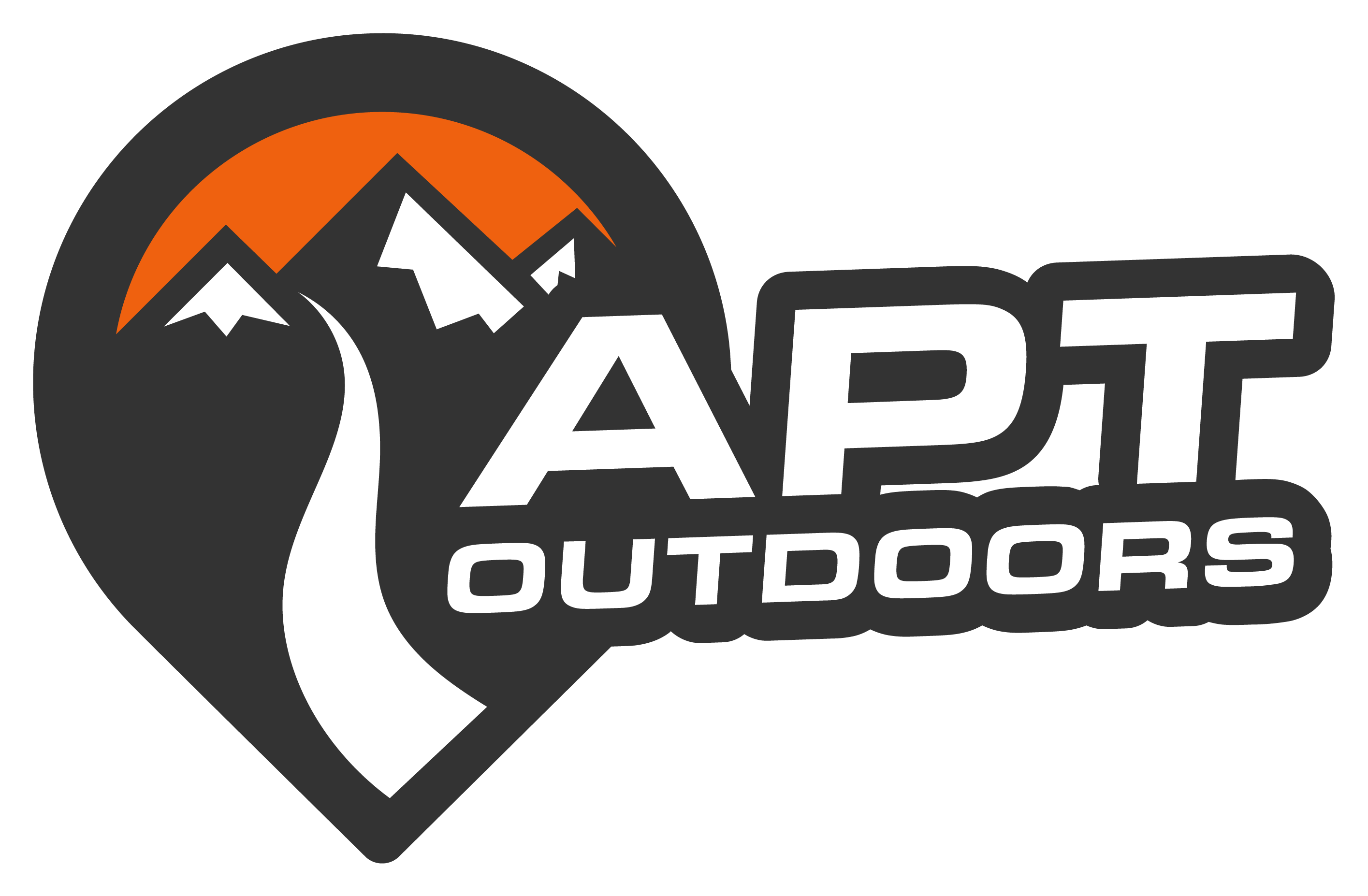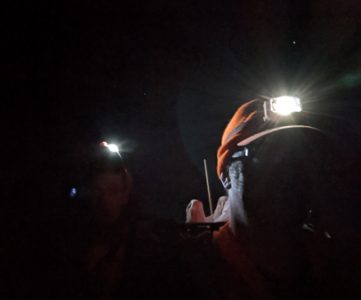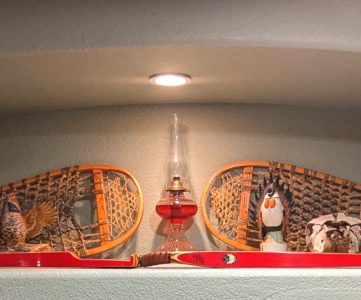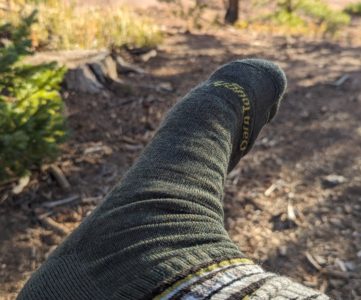Colorado OTC elk second rifle has been the sweet spot for my friends and I since I moved to Colorado in 2018, starting big game hunting in 2019. It offers availability and a nearest-to-the-rut non-draw rifle season that’s hard to pass up. I can save my elk points for an eventual hunt somewhere like the Weminuche Wilderness and hone my skills. Here’s a little recap of this year’s trip. If you follow me on social media I’m guessing you already saw the outcome.
Day 0
I’d slept overnight at our place, probably doing more camp chores than I should have in order to continuously improve our digs. Walls needed insulated, the new bathroom needed drywall and a medicine cabinet installed. It was hard not to tweak my back and shoulders trying to do too much. Thankfully it was nothing the seat heaters in the truck couldn’t handle. Danny arrived mid-morning and we commenced throwing gear into my truck after exchanging pleasantries. It’s the only time I get to see him these days. But we’d talked all year about this trip. After some reorganizing and getting to shoot the breeze a bit we were on the road.
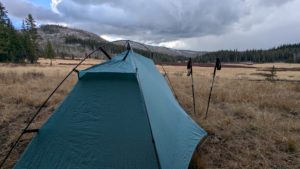
The place I’d had in mind was a bit of a hike, and not really close to anything. My anxiety usually builds as this is a public land hunt, and there’s a sort of race that occurs to get to “your spot”. I’d found some bulldozer trails that would get me to where I thought I wanted to be, but my level of scouting I’d been able to do over the summer was pretty limited if I’m being honest. I spent more time slinging drywall and working with the electricians to get our rooms in the back of our garage built. Knowing several seasons we’d had to scuttle backcountry camp, I wanted to have a game plan for much more posh accommodations if we needed them.
We wanted to do a little glassing as night crept up on us, but there were still some camp chores to be done. I grabbed the dirty water bag on my MSR Trailshot and walked over to where the creek beside us had deep pools. From the trees as I skylined myself I heard the upward tone of a person whistling for my attention.
I looked over my shoulder to see a gentlemen in hiking pants and a grey T-shirt with a pistol on his hip and a bino harness. I walked over and we struck up a conversation. He said his name was Ben, and that they’d hunted the general area for 15 years, and he was just coming in to see what was going to be out and about around dusk. During our brief conversation it felt like he’d validated all of my intel, and that they were successful more often than not back here and the general area in this part of the unit during second rifle.
Back at camp I got to glassing, laying back on my pack and studying the two mountains in front of me. I tore apart blowdown patches looking for something on a bed and found nothing. I kept hearing clattering in the woods and finally caught a glimpse of a bull elk going up and over the hill. Chances are we were in his neck of the woods for the week.
Day 1
I knew about where I wanted to be for the opening day, but not exactly how to get there. The spot I’d found wasn’t listed on any big hunting forums, but some other resources pointed me to some interesting drainages that might hold elk.
After coffee and a warm breakfast we headed out, waiting for first light so as to not have to struggle in the blow down suffer fest that was about to ensue. We knew we wanted to gain some elevation, but in doing so we’d have to climb through blowdown, swampy areas, and rocks. My worry was that sinking into the dark timber at the base of the mountain we wanted to climb would bust out some critters.
It turns out waiting until dawn and attempting to casually climb to 10,000ft was a bit of a challenge here. But getting to the top meant we could peer into two different Game Management Units, both were good for our second rifle OTC tags, but only one was good for our deer and my bear tags. Elk were our target for the first few days of the season. We’d agreed we wanted to pursue elk this year, and go hard. So we climbed.
We had to take frequent breaks but linked up with a trail, until we got into a saddle area. Then from there it was picking rock outcroppings to be able to glass from. Thermals were still in our favor with wind in our faces. But we still needed to go up and over the high point to view where we wanted to go for elk — at least where I thought they would be.
Elk!
It wasn’t until a little after noon or so that we made it to the far side of the glassing knob and set up. Though it didn’t take terribly long as I scanned every ridgeline from our commanding view. Seeing so much country at a time you’d think it would be easy to spot critters left and right, but we’d gotten somewhat disappointed by not seeing things just grazing everywhere. On top of that, the satellite imagery belied quite how rocky it was in this area after a few fires. In some areas it was barren, or at least seemingly so. But then it happened.
Across several ridge lines I spotted at first a small band of elk, maybe 6, but as I widened my search I saw more and more until there was over two dozen, probably more. I called to Danny, knowing that they were miles away from where we were. We both got some glass on them, and determined they were indeed elk, but my 12 power binos were failing me at exactly how big any bulls were. I snapped a few photos and digitally blew them up but they all looked like earth tone watercolor dots against the happy little pine trees, thanks Bob Ross.
Decision Time
Colorado OTC elk season is very competitive. There was one other hunter we’d seen all day, glassing the same area — but he lacked the elevation to see the herd we were glassing. We agonized over what to do. Legs hurting from the climb, we plotted a ridgeline attack — but it would be noisy. Miles of blowdown and trees that had been sitting for who knows how long would snap and pop like fireworks if we took the wrong line or we weren’t careful enough. While we had favorable wind it seemed like it would be setting us up for disappointment to scramble over miles of blowdown, through a tree line, and potentially skylining ourselves to even get a chance on the herd.
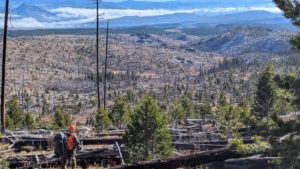
We decided it would be better, given the complete lack of pressure, to pull back and get back to camp. This has bitten me in the past, and I agonized over this decision for a long time. However, we figured the lack of pressure would ensure that they would stay in the area. Thankfully we took our exit in the light, because the alternatives were being cliffed out, scrambling over a boulder field, and high-lowing blowdown. We chose the blowdown.
Day 2
We wanted to get back into the valley where we’d seen the elk the previous night. Figuring since we saw them in the evening grazing at the top, surely with the weather we thought was coming they’d bed in the valley below.
This time there was no death march up a mountain to a glassing point. We waited for near daybreak and then skirted the tree lined edge of the meadows to get ourselves back as far into the valley as we could, believing that the elk would be bedded on our side of the mountain. As we walked we looked a the topo map, and followed cow paths toward the area we suspected the herd to have bedded. Breaching through a clump of trees we were stopped. A bull moose was broadside feeding in the meadow. He eyed us in the trees and kept feeding. There’s few things that scare me about critters in the woods, but an angry moose tops the list.
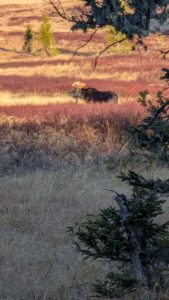
We weren’t particularly interested in drawing the ire of the moose and causing an issue. I was worried that we would blow out the elk if we caused too much drama. So we skirted the part of the meadow we had to traverse to get to where the elk might still be bedded.
Back Into the Timber
The alternative was basically to climb up a steep incline to be able to glass into the stretch of dark timber that the elk might have been bedded in. We started up the hill, thighs and knees still sore from yesterday but dosed up with ibuprofen. Gaining in elevation and making noise through the timber I figured there was no way we didn’t blow out elk — but there were still no signs of that happening. We found several beds that had probably been used a day or two before which felt like a good sign.
About halfway up the mountain I see on the map that there’s a path — a USFS designated trail. The closer we get, the more unlikely being able to actually utilize the trail it becomes. Blowdown almost solid across the well worn trail. We rested and strategized. Daylight was burning, and with how long it would take us to get to the top of a glassing knob — to then probably have to chase elk anyway — well the effort didn’t seem terribly worth it unless we were willing to commit. Instead, we figured, with a midday thermal flip the breeze would come down the mountain, and it would mean positioning ourselves for the evening would be more lucrative. It was only nine in the morning but the effort to get up in elevation for another thousand feet with some trail and then getting into position.
So down we went again. I’d had the foresight earlier working through the timber to throw a cow elk diaphragm call in my mouth. As we moved and tried to stay quiet, I would bleat out cow calls. It was the best I thought I could do while working our way through what had clearly been a bedding area only a few nights before. We were about to where we first saw the moose, planning on moving across the field to the far side to set up and glass into the other patch of trees when I spotted some movement. I figured it was the moose coming over to admonish us for being in his living room.
A Chance Encounter
It all happened extremely quickly. I heard some crashing on our right hand side, we expected it was the moose that was angry and wanted to come be angry in our general direction. Instead when I saw the shape of the head as it emerged, and the antlers on it’s head I whisper-yelled “Bull!” to Danny.
It emerged from the pines, and made a sort of serpentine motion through the meadow quartering to, briefly broadside, quartering away. He’d paused briefly and it may have been to study us, or it may have been to express disgust that we weren’t the cows walking through all that deadfall.
I did a quick check to make sure there were four points on one side, flicked the safety off of my Tikka and fired, perhaps a little high behind the shoulder, but it was a quick shot, and a close one at about 40 yards. The elk had put his head up as if to bugle, but never got the chance to exhale. Down in one. He’d fallen more or less where he stood.
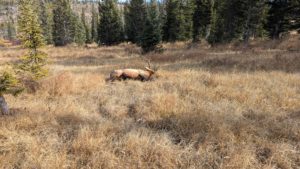
Now, the Real Work
I shot an inReach message to my wife, my dad, a few buddies, and one of my normal hunting partners Manny who had taken this trip off for a birthday celebration. I posed for a few pictures, and we contemplated the logistics of what we’d just done. The tiny Garmin sung out with congratulations as we began cutting up the elk. I pulled the trigger at roughly 0945, and by 1500 we were ready to throw packs on and get the first loads back to our backcountry camp.

We decided to throw the heaviest loads on our backs first. The rear hams. I honestly have no idea what they weighed, but it felt like an extra 70lbs a piece on our pack frames. We worked our way back to camp via cow paths only to one again meet the moose, who was more angry this time that we kept pestering his grazing.

We detoured again, up and away from the moose and found that the snow in the shadows had fairly fresh cat tracks, and we had meat on our backs now. This area is littered with predators, so my mind had a hard time not keeping that in the background. We got back to camp without further issue — the moose casually strolling after us a few hundred yards at our backs.
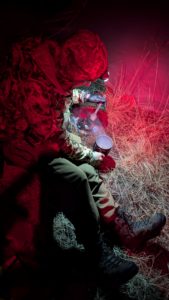
By Sunday night we’d realized that we only really had one hot backpacking meal between the two of us. We’d miscalculated bringing only two days of food to scout the location, so we split Danny’s Biscuits and Gravy that night and had some elk backstrap fried in Coconut oil kinda like a bougie backcountry chislic to fill in the gaps. Sure, there was food in the truck, but we were exhausted. So we ate up, and fell asleep in record time.
Day 3+
On the third morning we knew it was going to be an entire day of packing things back to camp. We’d cut up the elk and had made some trips to camp. However there was still the matter of being able to get everything else out the 2.5ish miles back to the truck. From the kill site to the camp it was bushwhacking, but from camp to the truck it was a slog over a trail that seemed to be uphill both ways. Then it snowed.
Thankfully we decided that after some exhausting times packing meat that we could run some stuff to my camp and sleep on some cots in the warmth of my now-heated back rooms.
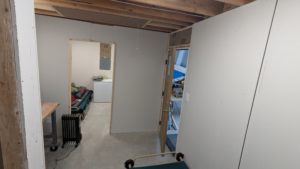
After having packed some meat out in a snowstorm, and knowing we had four loads left to pack out in the morning to the truck including the head and our camp, it made sense to bring out my Jet Sled. While it wasn’t particularly easy, it felt easier than shuttling more loads back and forth to the truck. The sled really saved us even with a few inches of snow on the ground. Once the last loads were back to the truck — it felt like it was time to cut meat, hang out, and celebrate a little.
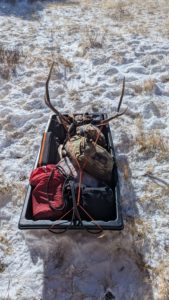
Pivot to Mule Deer
We spent the remainder of the season trying to connect Danny with a mule deer, and despite some encounters we just couldn’t seal the deal. I was looking in earnest for a mule deer buck representative of the region but only saw a forky and a 3×2 and with my Pennyslvania season coming up I wanted some room in my freezer for some whitetail.
With the threat of weather that didn’t materialize in the way that the forecast had originally said — many hunters pressured the river valley in our unit and we didn’t see quite the volume of deer we were accustomed to. But of course… we saw more moose.
Lessons (Sorta) Learned
We’ll see if I truly internalize any of these. But I feel there were some takeaways from this season that are worth mentioning.
- Bring the spotting scope. I did not bring my spotting scope so I was limited to 12 power binoculars after having waited a year for the season and climbed 1100 vertical feet. Maybe a smaller “trail” version of my Vortex 60 power spotter and a trail tripod would have been ideal here. They make both 33 power and 48 power spotters. This was a day 1 mistake.
- Conditioning is everything. Packing out an elk is hard. I don’t know how people do this solo. Well I do, and it’s by being in better shape than me or killing them closer to the road. I should do one of those things.
- Make sure your knives are ridiculously sharp or you can field hone your knives. Thankfully at least Danny knows better than to waltz into a situation where you’re breaking down a cow sized critter than to have a dull knife. My knife was sharp but we dulled it very quickly. It may be worth having something separate to do your caping and your meat cutting.
- I like my MSR Trailshot water purifier for backcountry camping, but in freezing conditions the hose ices up. I could have done it inside of Danny’s hot tent, but I need to work some kinks out.
- I could probably use a pull harness for the Jet Sled if this is going to be a regular thing using it to tow loads in the snow.
Done. Until The Next Time
This is definitely one of those experiences where I realized I didn’t fully prepare — or at least I let myself get complacent at some point during the summer. It sucked. Climbing the hills, dulling my knife cutting meat, fighting critters to get to where I wanted to go, hauling meat. And I will absolutely do it again.
To be able to bail out of my job, and society, if only for a week generates so much more rest and mindfulness for me than sitting on a beach sipping pina coladas. I’m thankful that my family gives me this time, and occasionally I can come home with filled tags.
